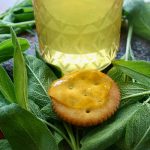The following basic herbal jelly recipe can be adapted for use with any herb and fruit juice combination. The combination I’m making here is sage and pineapple juice. I’ve also made cranberry-basil jelly and lemon-parsley jelly, both of which are delicious!
The secret to making tasty herbal jelly is to use fresh herbs. In my opinion, there’s no substitute to growing your own herbs. Even people living in apartments can grow herbs indoors. Fresh herbs provide the bright flavor for these savory jellies that make them unique.
How to Make Herbal Jelly
Herbal jelly uses an infusion of herbs in a base of fruit juice, sugar, lemon juice or vinegar, and liquid pectin. Cook the mixture at a hard boil (more on that later) and then poured into jars. Enjoy immediately or preserve it for use. I’ve provided instructions for canning it, too. I love giving them as gifts. They are so pretty!
What Is an Herbal Infusion?
Don’t let the word “infusion” scare you. An herbal infusion simply means a strong tea made from herbs and liquid. To make an herbal infusion:
- Pick fresh herbs.
- Clean the herbs.
- Chop them up and put them in a heat-proof container.
- Pour boiling liquid over them (water or juice).
- Cover. Some of the flavor is lost in the steam. Covering it returns the flavor back to the mixture.
- Wait until the mixture cools. Then, strain out the herbs. Retain the liquid.
You’ve just made an herbal infusion. Congratulations!
Herb and Fruit Juice Combinations for Herbal Jelly Recipes
There’s really no limit to the herb and fruit juice combinations you can use for the basic herbal jelly recipe. A few of my favorite combinations include:
- Cranberry juice and basil
- Lemon juice and parsley
- Grapefruit juice and rosemary
- Orange juice and rosemary
- Pineapple juice and sage
Look for fruit juice at the supermarket labeled 100% fruit juice.
History of Herbal Jelly
The first time I made I made jelly from herbs, my husband looked at me like I was crazy. He thought it was some new-fangled craze. However, the history of jelly dates back to possibly the Persian empire. Sugar was grown in the Middle East as far back as 500 B.C.E.
The first evidence we read of jellies made with herbs comes from the court of Louis XIV. His court enjoyed jelly for dessert. Because sugar was imported, it was expensive, and only the aristocracy could afford the amount of sugar needed to make jelly.
Savory jellies like this recipe for herb jelly were popular during the Victorian era as well. This recipe possibly dates from that time period. Tea might be served with breads, small tea cakes, and pots of sweet and savory jelly. Pineapple-sage jelly would have been an expensive treat in that time period since pineapple was only grown in greenhouses in England. Apple juice or pear juice may have been used as a base for many savory jellies of that period.
Today, no company that I’m aware of produces herbal jellies, so learning to make a recipe for herbal jelly ensures that you have plenty of this gourmet treat on hand.
Indoor Herb Gardening Online Class
Love herbs? Learn how to grow herbs indoors! Summer savory is one of the many herbs you can easily grow in pots on a kitchen windowsill. This course will show you how.

Recipe for Herbal Jelly – Pineapple Sage Jelly
Ingredients
- 1 cup fresh sage leaves clean and chop the leaves
- 2 1/2 cups pineapple juice use 100% juice
- 4 cups Sugar
- 1 package liquid pectin use only liquid pectin – 3 ounces
- 1/4 cup freshly squeezed lemon juice
Instructions
- Clean and chop the fresh sage leaves. Place one cup of leaves in a heat-proof bowl.
- Heat pineapple juice to boiling. Pour over the sage leaves. Cover and let sit until cool.
- Once cool, strain the herbs out, and place the pineapple juice sage in a large saucepan. Add the lemon juice and sugar, stirring over high heat until it comes to a boil.
- Stir in the envelope of liquid pectin, squeezing it to get out every drop. Keep stirring the mixture and bring it to a hard, rolling boil over high heat. Heat and stir for one minute. Do not stop stirring or it might boil over!
- Pour the jelly mixture into half-pint jelly jars. If you are going to can the jelly to preserve it for long storage, continue with the steps below. If not, allow the jelly jars to cool on the counter to room temperature, then refrigerate them for use. They will keep in the refrigerator for 3 months.
Processing the Jelly: Hot Water Bath Canning Method
- Heat a hot water bath canner with enough water to cover the jars by one inch of water.
- Pour jelly into half-pint jelly jars leaving 1/2 inch of heat space.
- Wipe the rims clean with a moistened paper towel.
- Place warmed canning jar lids over each jar. Screw on the band to finger-tight.
- Place closed jars into the hot water bath canner. Make sure there is 1 inch of water covering the tops of the jars. Cover canner.
- Heat to boiling, then process for 10 minutes.
- Remove lid after 10 minutes to allow steam to escape.
- Take the jars out of the canner and place on a board or heat-proof surface until they seal.
